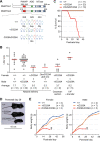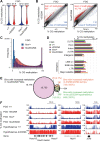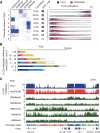The DNMT3A PWWP domain is essential for the normal DNA methylation landscape in mouse somatic cells and oocytes
- PMID: 34048432
- PMCID: PMC8162659
- DOI: 10.1371/journal.pgen.1009570
The DNMT3A PWWP domain is essential for the normal DNA methylation landscape in mouse somatic cells and oocytes
Abstract
DNA methylation at CG sites is important for gene regulation and embryonic development. In mouse oocytes, de novo CG methylation requires preceding transcription-coupled histone mark H3K36me3 and is mediated by a DNA methyltransferase DNMT3A. DNMT3A has a PWWP domain, which recognizes H3K36me2/3, and heterozygous mutations in this domain, including D329A substitution, cause aberrant CG hypermethylation of regions marked by H3K27me3 in somatic cells, leading to a dwarfism phenotype. We herein demonstrate that D329A homozygous mice show greater CG hypermethylation and severer dwarfism. In oocytes, D329A substitution did not affect CG methylation of H3K36me2/3-marked regions, including maternally methylated imprinting control regions; rather, it caused aberrant hypermethylation in regions lacking H3K36me2/3, including H3K27me3-marked regions. Thus, the role of the PWWP domain in CG methylation seems similar in somatic cells and oocytes; however, there were cell-type-specific differences in affected regions. The major satellite repeat was also hypermethylated in mutant oocytes. Contrary to the CA hypomethylation in somatic cells, the mutation caused hypermethylation at CH sites, including CA sites. Surprisingly, oocytes expressing only the mutated protein could support embryonic and postnatal development. Our study reveals that the DNMT3A PWWP domain is important for suppressing aberrant CG hypermethylation in both somatic cells and oocytes but that D329A mutation has little impact on the developmental potential of oocytes.
Conflict of interest statement
The authors have declared that no competing interests exist.
Figures





Similar articles
-
H3K36me2/3 Binding and DNA Binding of the DNA Methyltransferase DNMT3A PWWP Domain Both Contribute to its Chromatin Interaction.J Mol Biol. 2019 Dec 6;431(24):5063-5074. doi: 10.1016/j.jmb.2019.09.006. Epub 2019 Oct 18. J Mol Biol. 2019. PMID: 31634469
-
A DNMT3A PWWP mutation leads to methylation of bivalent chromatin and growth retardation in mice.Nat Commun. 2019 Apr 23;10(1):1884. doi: 10.1038/s41467-019-09713-w. Nat Commun. 2019. PMID: 31015495 Free PMC article.
-
The histone mark H3K36me2 recruits DNMT3A and shapes the intergenic DNA methylation landscape.Nature. 2019 Sep;573(7773):281-286. doi: 10.1038/s41586-019-1534-3. Epub 2019 Sep 4. Nature. 2019. PMID: 31485078 Free PMC article.
-
DNA Methyltransferases in Mammalian Oocytes.Results Probl Cell Differ. 2017;63:211-222. doi: 10.1007/978-3-319-60855-6_10. Results Probl Cell Differ. 2017. PMID: 28779320 Review.
-
Acute myeloid leukemia-associated DNMT3A p.Arg882His mutation in a patient with Tatton-Brown-Rahman overgrowth syndrome as a constitutional mutation.Am J Med Genet A. 2017 Jan;173(1):250-253. doi: 10.1002/ajmg.a.37995. Epub 2016 Nov 7. Am J Med Genet A. 2017. PMID: 27991732 Review.
Cited by
-
Expression analysis suggests that DNMT3L is required for oocyte de novo DNA methylation only in Muridae and Cricetidae rodents.Epigenetics Chromatin. 2023 Nov 4;16(1):43. doi: 10.1186/s13072-023-00518-2. Epigenetics Chromatin. 2023. PMID: 37924163 Free PMC article.
-
Roles of endogenous retroviral elements in the establishment and maintenance of imprinted gene expression.Front Cell Dev Biol. 2024 Mar 5;12:1369751. doi: 10.3389/fcell.2024.1369751. eCollection 2024. Front Cell Dev Biol. 2024. PMID: 38505259 Free PMC article. Review.
-
Specific DNMT3C flanking sequence preferences facilitate methylation of young murine retrotransposons.Commun Biol. 2024 May 16;7(1):582. doi: 10.1038/s42003-024-06252-z. Commun Biol. 2024. PMID: 38755427 Free PMC article.
-
Maternal obesity may disrupt offspring metabolism by inducing oocyte genome hyper-methylation via increased DNMTs.Elife. 2024 Dec 6;13:RP97507. doi: 10.7554/eLife.97507. Elife. 2024. PMID: 39642055 Free PMC article.
-
The UHRF protein family in epigenetics, development, and carcinogenesis.Proc Jpn Acad Ser B Phys Biol Sci. 2022;98(8):401-415. doi: 10.2183/pjab.98.021. Proc Jpn Acad Ser B Phys Biol Sci. 2022. PMID: 36216533 Free PMC article. Review.
References
Publication types
MeSH terms
Substances
LinkOut - more resources
Full Text Sources
Other Literature Sources
Molecular Biology Databases

